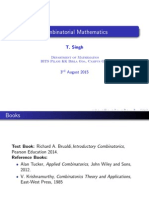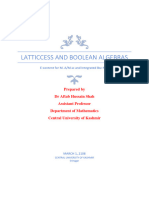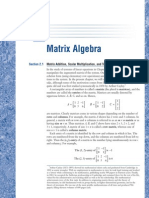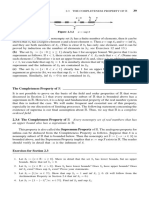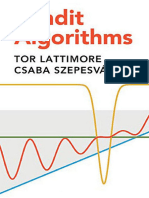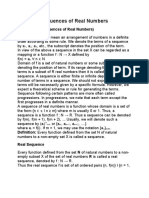Partial Orderings: Rosen, Chapter 8.6 Modified by Longin Jan Latecki
Partial Orderings: Rosen, Chapter 8.6 Modified by Longin Jan Latecki
Uploaded by
Prasetyo Indra SuronoCopyright:
Available Formats
Partial Orderings: Rosen, Chapter 8.6 Modified by Longin Jan Latecki
Partial Orderings: Rosen, Chapter 8.6 Modified by Longin Jan Latecki
Uploaded by
Prasetyo Indra SuronoOriginal Title
Copyright
Available Formats
Share this document
Did you find this document useful?
Is this content inappropriate?
Copyright:
Available Formats
Partial Orderings: Rosen, Chapter 8.6 Modified by Longin Jan Latecki
Partial Orderings: Rosen, Chapter 8.6 Modified by Longin Jan Latecki
Uploaded by
Prasetyo Indra SuronoCopyright:
Available Formats
1
Partial Orderings
Based on Slides by Chuck Allison from
http://uvsc.freshsources.com/Courses/CS_2300/Slides/slides.html
Rosen, Chapter 8.6
Modified by Longin Jan Latecki
2
Introduction
An equivalence relation is a relation that is
reflexive, symmetric, and transitive
A partial ordering (or partial order) is a relation that
is reflexive, antisymmetric, and transitive
Recall that antisymmetric means that if (a,b) e R, then
(b,a) e R unless b = a
Thus, (a,a) is allowed to be in R
But since its reflexive, all possible (a,a) must be in R
3
Partially Ordered Set (POSET)
A relation R on a set S is called a partial
ordering or partial order if it is reflexive,
antisymmetric, and transitive. A set S together
with a partial ordering R is called a partially
ordered set, or poset, and is denoted by (S, R)
4
Example (1)
Let S = {1, 2, 3} and
let R = {(1,1), (2,2), (3,3), (1, 2), (3,1), (3,2)}
1
2
3
5
In a poset the notation a b denotes that
This notation is used because the less than or
equal to relation is a paradigm for a partial ordering.
(Note that the symbol is used to denote the
relation in any poset, not just the less than or
equals relation.) The notation a b denotes that
a b, but
( , ) a b R e
a b =
6
Example
Let S = {1, 2, 3} and
let R = {(1,1), (2,2), (3,3), (1, 2), (3,1), (3,2)}
1
2
3
2 2 3 2
7
Example (2)
Show that is a partial order on the set of integers
It is reflexive: a a for all a e Z
It is antisymmetric: if a b then the only way that
b a is when b = a
It is transitive: if a b and b c, then a c
Note that is the partial ordering on the set of
integers
(Z, ) is the partially ordered set, or poset
8
Example (3)
Consider the power set of {a, b, c} and the
subset relation. (P({a,b,c}), )
Draw a graph of this relation.
_
9
Comparable / Incomparable
The elements a and b of a poset (S, ) are
called comparable if either a b or b a.
When a and b are elements of S such that
neither a b nor b a, a and b are called
incomparable.
10
Example
_
Consider the power set of {a, b, c} and the
subset relation. (P({a,b,c}), )
{ , } { , } and { , } { , } a c a b a b a c . .
So, {a,c} and {a,b} are incomparable
11
(S, )
If is a poset and every two elements of
S are comparable, S is called totally ordered or
linearly ordered set, and is called a total
order or a linear order. A totally ordered set is
also called a chain.
Totally Ordered, Chains
12
In the poset (Z
+
,), are the integers 3 and 9
comparable?
Yes, as 3 9
Are 7 and 5 comparable?
Yes, as 5 7
As all pairs of elements in Z
+
are comparable,
the poset (Z
+
,) is a total order
a.k.a. totally ordered poset, linear order, or chain
13
In the poset (Z
+
,|) with divides operator |,
are the integers 3 and 9 comparable?
Yes, as 3 | 9
Are 7 and 5 comparable?
No, as 7 | 5 and 5 | 7
Thus, as there are pairs of elements in Z
+
that are not comparable, the poset (Z
+
,|) is a
partial order. It is not a chain.
14
15
(S, )
is a well-ordered set if it is a poset such
that is a total ordering and such that every
nonempty subset of S has a least element.
Well-Ordered Set
Example: Consider the ordered pairs of positive
integers, Z
+
x Z
+
where
1 2 1 2 1 1 1 1 2 2
( , ) ( , ) if , or if and a a b b a b a b a b < = s
16
Well-ordered sets examples
Example: (Z,)
Is a total ordered poset (every element is comparable to
every other element)
It has no least element
Thus, it is not a well-ordered set
Example: (S,) where S = { 1, 2, 3, 4, 5 }
Is a total ordered poset (every element is comparable to
every other element)
Has a least element (1)
Thus, it is a well-ordered set
17
Lexicographic Order
This ordering is called lexicographic because it
is the way that words are ordered in the
dictionary.
18
19
For any positive integers m and n and a
1
a
2
a
m
and
b
1
b
2
b
n
in .
1. If and a
i
= b
i
for all i = 1, 2, , . . ., m, then
a
1
,a
2
a
m
b
1
b
2
.b
n
.
2. If for some integer k with
for all i = 1,2,,k-1, and a
k
R b
k
but , then
a
1
,a
2
a
m
b
1
b
2
.b
n
.
3. If is the null string and s is any string in
then s.
m n s
*
Let be a finite set and suppose R is a partial order
relation defined on . Define a relation on , the set
of all strings over , as follows:
, , and 1,
i i
k m k n k a b s s > =
k k
a b =
c
c
*
20
The Principle of Well-Ordered
Induction
Suppose that S is a well-ordered set. Then P(x)
is true for all x S, if:
BASIS STEP: P(x
0
) is true for the least
element of S, and
INDUCTION STEP: For every y S if P(x) is
true for all x y, then P(y) is true.
e
e
21
Hasse Diagrams
Given any partial order relation defined on a
finite set, it is possible to draw the directed
graph so that all of these properties are
satisfied.
This makes it possible to associate a
somewhat simpler graph, called a Hasse
diagram, with a partial order relation defined
on a finite set.
22
Hasse Diagrams (continued)
Start with a directed graph of the relation in
which all arrows point upward. Then
eliminate:
1. the loops at all the vertices,
2. all arrows whose existence is implied by the
transitive property,
3. the direction indicators on the arrows.
23
Example
Let A = {1, 2, 3, 9, 18} and consider the divides
relation on A:
For all , , | for some integer . a b A a b b ka k e =
1
2
3
9
18
24
Example
Eliminate the loops at all the vertices.
1
2
3
9
18
Eliminate all arrows whose existence is implied by the transitive
property.
Eliminate the direction indicators on the arrows.
25
Hasse Diagram
For the poset ({1,2,3,4,6,8,12}, |)
26
27
a is a maximal in the poset (S, ) if there is no
such that a b. Similarly, an element of a poset is
called minimal if it is not greater than any element of
the poset. That is, a is minimal if there is no element
such that b a.
It is possible to have
multiple minimals and maximals.
Maximal and Minimal Elements
b S e
b S e
28
a is the greatest element in the poset (S, ) if b a
for all . Similarly, an element of a poset is called
the least element if it is less or equal than all other
elements in the poset. That is, a is the least element if
a b for all
Greatest Element
Least Element
b S e
b S e
29
Upper bound, Lower bound
Sometimes it is possible to find an element that is
greater than all the elements in a subset A of a poset
(S, ). If u is an element of S such that a u for all
elements , then u is called an upper bound of A.
Likewise, there may be an element less than all the
elements in A. If l is an element of S such that l a
for all elements , then l is called a lower bound of
A.
a A e
a A e
Examples 18, p. 574 in Rosen.
30
Least Upper Bound,
Greatest Lower Bound
The element x is called the least upper bound (lub) of
the subset A if x is an upper bound that is less than
every other upper bound of A.
The element y is called the greatest lower bound (glb)
of A if y is a lower bound of A and z y whenever z is
a lower bound of A.
Examples 19 and 20, p. 574 in Rosen.
31
Lattices
A partially ordered set in which every pair
of elements has both a least upper bound
and a greatest lower bound is called a
lattice.
32
Examples 21 and 22, p. 575 in Rosen.
33
Lattice Model
(LinuxSecurity.com)
(I) A security model for flow control in a system, based on the
lattice that is formed by the finite security levels in a system and
their partial ordering. [Denn] (See: flow control, security level,
security model.) (C) The model describes the semantic structure
formed by a finite set of security levels, such as those used in
military organizations. (C) A lattice is a finite set together with a
partial ordering on its elements such that for every pair of elements
there is a least upper bound and a greatest lower bound. For
example, a lattice is formed by a finite set S of security levels --
i.e., a set S of all ordered pairs (x, c), where x is one of a finite set
X of hierarchically ordered classification levels (X1, ..., Xm), and c
is a (possibly empty) subset of a finite set C of non-hierarchical
categories (C1, ..., Cn) -- together with the "dominate" relation.
(See: dominate.)
34
Topological Sorting
A total ordering is said to be
compatible with the partial ordering R if
a b whenever a R b. Constructing a
total ordering from a partial ordering is
called topological sorting.
35
0 1 2 3
4
5 6
7 8 9
If there is an edge from v to w, then v
precedes w in the sequential listing.
9 6 3 4 8 2 0 5 1 7
36
Example
Consider the set A = {2, 3, 4, 6, 18, 24} ordered
by the divides relation. The Hasse diagram
follows:
The ordinary less than or equal to relation on
this set is a topological sorting for it since for
positive integers a and b, if a|b then a b.
s
s
24
4
2
18
6
3
37
Topological Sorting
38
Assemble an Automobile
1) Build Frame
2) Install engine, power train components, gas
tank.
3) Install brakes, wheels, tires.
4) Install dashboard, floor, seats.
5) Install electrical lines.
6) Install gas lines.
7) Attach body panels to frame
8) Paint body.
39
Prerequisites
Task Immediately Preceding
Tasks
Time Needed to
Perform Task
1
2
3
4
5
6
7
8
9
1
1
2
2, 3
4
2, 3
4, 5
6, 7, 8
7 hours
6 hours
3 hours
6 hours
3 hours
1 hour
1 hour
2 hours
5 hours
40
Example Job Scheduling
What is the total order compatible with it?
Task 1
7 hours
Task 2
6 hours
Task 3
3 hours
Task 4
6 hours
Task 5
3 hours
Task 7
1 hour
Task 6
1 hour
Task 8
2 hour
Task 9
5 hour
41
42
Example 27, p. 578 in Rosen.
You might also like
- Partial OrderingDocument31 pagesPartial OrderingPankaj BharangarNo ratings yet
- Announcements: Recursively-Defined Sequences ExampleDocument5 pagesAnnouncements: Recursively-Defined Sequences ExampleAnonymous bk7we8No ratings yet
- Abstract Algebra 1Document42 pagesAbstract Algebra 1SamNo ratings yet
- Digital Logic BasicsDocument50 pagesDigital Logic BasicsadityaNo ratings yet
- Groups & Symmetries NotesDocument49 pagesGroups & Symmetries NotesMichael SteeleNo ratings yet
- 07 Rules of InferenceDocument34 pages07 Rules of InferenceSawant_Ashish_609No ratings yet
- CombinatoricsDocument17 pagesCombinatoricschajedamanNo ratings yet
- PropLogic PDFDocument130 pagesPropLogic PDFrahul kumarrNo ratings yet
- UNIT-3 Set - TheoryDocument108 pagesUNIT-3 Set - TheorysaiNo ratings yet
- SRM University: Department of CseDocument47 pagesSRM University: Department of CseShreyas NagareNo ratings yet
- Methods of Proof: CS 202 Rosen Section 1.5 Aaron BloomfieldDocument71 pagesMethods of Proof: CS 202 Rosen Section 1.5 Aaron BloomfieldAhmed SaidNo ratings yet
- Proof TechniquesDocument144 pagesProof TechniquesAbdul hananNo ratings yet
- 6 RelationsDocument38 pages6 RelationsShaan Krazzi100% (1)
- HashingDocument37 pagesHashingRohan ChaudhryNo ratings yet
- CD Unit-2Document60 pagesCD Unit-2akashodspNo ratings yet
- Group Theory NotesDocument51 pagesGroup Theory NotesJan Hroch KošataNo ratings yet
- Chap 4 PDFDocument33 pagesChap 4 PDFSayyid JifriNo ratings yet
- Permutation & Combination in Brief StudyDocument13 pagesPermutation & Combination in Brief StudyBalmukundNo ratings yet
- CSE231 - Lecture 1Document31 pagesCSE231 - Lecture 1Rayhan Amin 2212830042No ratings yet
- Discrete Math 02 - Inference Rule and ProofsDocument40 pagesDiscrete Math 02 - Inference Rule and ProofsDesi D SimamoraNo ratings yet
- CSE231 - Lecture 2Document39 pagesCSE231 - Lecture 2Rayhan Amin 2212830042No ratings yet
- 2 LatticesDocument47 pages2 LatticesAkash PrasharNo ratings yet
- Gate Mathematics BasicsDocument11 pagesGate Mathematics Basicsprabhu81No ratings yet
- 4.3 Partial Ordering 0Document33 pages4.3 Partial Ordering 0laura.bianca.biliusNo ratings yet
- Clark W Edwin Elementary Number TheoryDocument129 pagesClark W Edwin Elementary Number TheoryDireshan Pillay100% (1)
- Group 1 - Structure of ComputersDocument115 pagesGroup 1 - Structure of ComputersPELAGIO, Angelo Uriel R.100% (1)
- Lattices and Boolean AlgebrasDocument93 pagesLattices and Boolean Algebrasrehan8856811155No ratings yet
- Chap1 PDFDocument29 pagesChap1 PDFEquinox EducationNo ratings yet
- Introduction To Abstract Algebra - Math 113 - Paulin PDFDocument78 pagesIntroduction To Abstract Algebra - Math 113 - Paulin PDFPhilip OswaldNo ratings yet
- Linear Algebra With Probability PDFDocument73 pagesLinear Algebra With Probability PDFShan De SilvaNo ratings yet
- M.sc. (Maths) Book Final 29-11-18 PDFDocument171 pagesM.sc. (Maths) Book Final 29-11-18 PDFMandeep Singh RanaNo ratings yet
- CSE231 Lecture 6Document31 pagesCSE231 Lecture 6Rayhan Amin 2212830042No ratings yet
- CSE231 - Lecture 5Document33 pagesCSE231 - Lecture 5Rayhan Amin 2212830042No ratings yet
- MA8351 DISCRETE MATHEMATICS SyllabusDocument2 pagesMA8351 DISCRETE MATHEMATICS SyllabusSelvam ChidambaramNo ratings yet
- Codigo Metodo Quine - MckluskyDocument45 pagesCodigo Metodo Quine - MckluskyCez MartinezNo ratings yet
- Abstract Algebra: P Kalika NotesDocument50 pagesAbstract Algebra: P Kalika NotesSubhajit MullickNo ratings yet
- Indian Math OlympiadDocument1 pageIndian Math OlympiadMahendra DabralNo ratings yet
- Lattice TheoryDocument36 pagesLattice TheoryShravya S MallyaNo ratings yet
- ISI +Number+TheoryDocument48 pagesISI +Number+TheoryVanshNo ratings yet
- Quadratic ResiduesDocument5 pagesQuadratic Residuesgzb012No ratings yet
- MCA Data Structures With Algorithms 01Document16 pagesMCA Data Structures With Algorithms 01JuanNo ratings yet
- Real Analysis MathematicsDocument16 pagesReal Analysis MathematicsLee Zhi KangNo ratings yet
- 1 Complex Numbers PartDocument15 pages1 Complex Numbers PartVeer Tøny SinghNo ratings yet
- Reflexive Relation: R A A, Ara. R ADocument9 pagesReflexive Relation: R A A, Ara. R ATalha Nazeer100% (1)
- Rational Functions: AsymptotesDocument2 pagesRational Functions: AsymptotesMUDASSIRNo ratings yet
- Cmpe 30094 Logic Circuits and Design Instructional Materials Version 2.02Document183 pagesCmpe 30094 Logic Circuits and Design Instructional Materials Version 2.02cyber4815No ratings yet
- Analysis IDocument64 pagesAnalysis IPătularu andreiNo ratings yet
- Volume 1Document745 pagesVolume 1Kirti MittalNo ratings yet
- DSD Module-5 Prakash VDocument106 pagesDSD Module-5 Prakash Vmanansakhiya3112100% (1)
- Matrix AlgebraDocument63 pagesMatrix AlgebraSagar DamaniNo ratings yet
- Integer Sequences and Circle Chains Inside A HyperbolaDocument6 pagesInteger Sequences and Circle Chains Inside A HyperbolaDũng Nguyễn TiếnNo ratings yet
- Assignment No.2 - Design and Analysis of AlgorithmsDocument37 pagesAssignment No.2 - Design and Analysis of Algorithmsamir hameedNo ratings yet
- 100 GOAT Problems of Sequence & SeriesDocument203 pages100 GOAT Problems of Sequence & Seriesmohdamaankhan74No ratings yet
- Mock Test Csir Net MathsDocument33 pagesMock Test Csir Net MathsSimran KaurNo ratings yet
- Quadratic Forms & Applications To Geometry - Reducing Quadric To Canonical Standard Form - Schulstad 1967Document34 pagesQuadratic Forms & Applications To Geometry - Reducing Quadric To Canonical Standard Form - Schulstad 1967dbowden333No ratings yet
- Statement Form:: For ExampleDocument19 pagesStatement Form:: For ExampleMr. JahirNo ratings yet
- Mathmatical Methods FinalDocument371 pagesMathmatical Methods FinalAyomikunNo ratings yet
- JEE BooksDocument20 pagesJEE BooksGaurav VirmaniNo ratings yet
- Por PDFDocument13 pagesPor PDFLilian E AbukeNo ratings yet
- Compactness and Connectedness Continuity Theorems.Document4 pagesCompactness and Connectedness Continuity Theorems.ap021No ratings yet
- Solved Problems On Supremum and InfimumDocument7 pagesSolved Problems On Supremum and InfimumakilNo ratings yet
- AnalysisI Lecture NotesDocument114 pagesAnalysisI Lecture NotesChandan GuptaNo ratings yet
- Domain TheoryDocument167 pagesDomain TheoryjcmatiasNo ratings yet
- Variation in PrinciplesDocument410 pagesVariation in PrinciplesiwakunbNo ratings yet
- Antisymmetric VS. Asymmetric Discrete StructuresDocument8 pagesAntisymmetric VS. Asymmetric Discrete Structuresgbland100% (1)
- Syllabus of Introduction To Analysis RealDocument4 pagesSyllabus of Introduction To Analysis RealOktavianus OktaNo ratings yet
- Ex-2 3Document2 pagesEx-2 3Muhammad Arshad JaferNo ratings yet
- Lectures 1Document98 pagesLectures 1Shy RonnieNo ratings yet
- G. T. CH 2Document28 pagesG. T. CH 2ZneNo ratings yet
- Bandit Algorithms (Tor Lattimore, Csaba Szepesvári) (Z-Library)Document537 pagesBandit Algorithms (Tor Lattimore, Csaba Szepesvári) (Z-Library)athenavladivostok0% (1)
- Fa e PDFDocument289 pagesFa e PDFHerhes Cosme100% (1)
- Book by Jaromir KubenDocument523 pagesBook by Jaromir Kubenkothapalli21No ratings yet
- Coprime FactorisationDocument20 pagesCoprime FactorisationasgharNo ratings yet
- Math 105 Written ReportDocument13 pagesMath 105 Written ReportCrysvenne Perez BisligNo ratings yet
- Lattice-Theoretical Fixpoint TheoremDocument26 pagesLattice-Theoretical Fixpoint TheoremGreeetttNo ratings yet
- Download Full An Introduction to Measure and Integration 2nd Edition Inder K. Rana PDF All ChaptersDocument85 pagesDownload Full An Introduction to Measure and Integration 2nd Edition Inder K. Rana PDF All Chaptersmaebyluzzib9100% (3)
- Problem Set 1Document32 pagesProblem Set 1bobNo ratings yet
- Syllabus NEP Mathematics Deptt-2Document11 pagesSyllabus NEP Mathematics Deptt-2Biplab DoleyNo ratings yet
- Course Notes For EE394V Restructured Electricity Markets: Locational Marginal PricingDocument95 pagesCourse Notes For EE394V Restructured Electricity Markets: Locational Marginal Pricingogun_luNo ratings yet
- Full Download Invitation To Classical Analysis 1st Edition Peter Duren PDFDocument84 pagesFull Download Invitation To Classical Analysis 1st Edition Peter Duren PDFkibelamjel100% (1)
- 2.3 Bounded Functions: 2.3.1 Suprema and in Ma of A FunctionDocument6 pages2.3 Bounded Functions: 2.3.1 Suprema and in Ma of A FunctionAhsan HafeezNo ratings yet
- UCS405 Lec 24Document22 pagesUCS405 Lec 24pkapurbe22No ratings yet
- Lattices: Definition:: MAT1014-Module-4, Dr. Ezhilmaran 1 3/13/2017Document26 pagesLattices: Definition:: MAT1014-Module-4, Dr. Ezhilmaran 1 3/13/2017Prakruthi KsNo ratings yet
- Analysis 1 Chapter 01Document35 pagesAnalysis 1 Chapter 01nadirkadi100107No ratings yet
- Infinitesimals PDFDocument9 pagesInfinitesimals PDFtomdavis777100% (1)
- A Variational Inequality Formulation of The Dynamic Network User EquilibriumDocument14 pagesA Variational Inequality Formulation of The Dynamic Network User EquilibriumShangbo WangNo ratings yet
- Real Analysis Cheat SheetDocument8 pagesReal Analysis Cheat SheetJoannaWilliamsNo ratings yet
- Sequences of Real NumbersDocument55 pagesSequences of Real NumbersVijay ChhipaNo ratings yet






